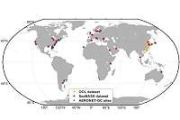The Cryogenic Dark Matter Search (CDMS) is a series of experiments designed directly to detect particle dark matter in the form of WIMPs.
Using an array of semiconductor detectors at millikelvin temperatures, CDMS has set the most sensitive limits to date on the interactions of WIMP dark matter with terrestrial materials. The first experiment, CDMSI, was run in a tunnel under the Stanford University campus. The current experiment, CDMSII, is located deep underground in the Soudan Mine in northern Minnesota.
SuperCDMS is the successor to CDMS II. The "super" refers to the larger, improved detectors. There are actually three generations of Super CDMS planned:
- SuperCDMS Soudan, with 9.3 kg of active detector mass made of 15×620 g germanium discs (76.2 mm/3″ diameter × 25.4 mm/1″ thick). This has been operating since March 2012.
- SuperCDMS SNOLAB, with 100–200 kg of active detector mass, made of 1380 g germanium discs (100 mm/3.9″ diameter × 33.3 mm/1.3″ thick). Development is underway, and it is hoped construction will begin in 2014. The deeper SNOLAB site will reduce cosmic ray backgrounds compared to Soudan.
- GEODM (Germanium Observatory for Dark Matter), with more than 1000 kg of detector mass. Preliminary planning hopes to install this in the DUSEL laboratory.























































